research
-
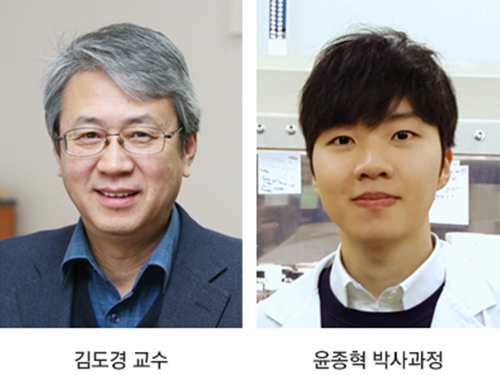 Capillary Forces at Work for Lithium-Sulfur Batteries
Professor Do Kyung Kim from the KAIST Department of Materials Science and Engineering and his team succeeded in developing high-areal-capacity lithium sulfur batteries (Li-S batteries) by capturing polysulfide with carbon nanofibers. This research will provide new batteries to replace existing lithium rechargeable batteries, shifting the commercialization of related technologies ahead.
Electrical vehicles and large-scale energy storage systems necessitate the development of batteries with high energy density and cost effectiveness, and Li-S batteries are known to be one of the promising alternatives to the predominant lithium ion batteries.
With six times as much energy density, Li-S batteries theoretically thrust electric vehicle to twice the distance of lithium ion batteries. Therefore, they have been spotlighted as next-generation lithium rechargeable batteries because they can go up to 400km once charged.
However, several issues make it challenging to readily commercialize Li-S batteries. The low electrical conductivity of sulfur, volumetric expansion and contraction of the battery during charge and discharge, and permanent damage of the electrode caused by the dissolution of the lithium polysulfide into the electrolyte – known as the “shuttle effect” – are three of the biggest obstacles to commercial-grade Li-S batteries.
While there have been numerous attempts to curb, avoid, or alleviate these issues — such as the physical encapsulation of sulfur using various metal oxides or carbonaceous matrices — most of them entail utilizing zero-dimensional (0D) carbon materials. This encapsulation method has been somewhat effective in enhancing the electrical conductivity of sulfur while simultaneously tolerating some volumetric alterations and suppressing the shuttle effect. The downside of 0D carbon material-based encapsulation methods is their complicated synthetic processing and the limited mass loading of sulfur.
With this in mind, the team set out to employ one-dimensional (1D) carbon materials instead. Unlike the 0D case, 1D carbon materials render a large surface area and a long-range conduction path for electrons and lithium ions. Being 1D also solves the undesirable high-contact resistance problem frequently encountered by 0D carbon material-based encapsulation.
The key to developing the proposed material was to exploit the capillary force to decrease the energy associated with the dissolution of polysulfides. As such, carbon nanofibers (CNFs) were found to be suitable for high-areal-capacity lithium-sulfur batteries since capillary force acting between CNFs can take advantage of the high electrical conductivity with the suppressed dissolution of sulfides.
The research findings show that sulfur was successfully contained in between the CNFs by wetting due to the capillary force without the need for complicated synthetic processing, as in the 0D case. The research results indicate that the sulfur contained per unit area (mg/cm2) is five times greater for the newly implemented method, which then enabled the lithium-sulfur battery to achieve an areal capacity of 7 mAh/cm2, which amounts to as much as at most seven times that of conventional lithium ion batteries.
First author Jong Hyuk Yun stated that the unprecedented methods utilized in this study will help further and widen the progress of lithium batteries in general. Meanwhile, Professor Kim said, “This study brought us closer to commercial-grade high-capacity Li-S batteries, which are applicable for a wide variety of products, including electric vehicles, unmanned aerial vehicles (UAVs), and drones.”
This research, led by PhD candidate Yun, was published in the 18th issue of this year’s Nano Letters.
Figure 1. Electrochemical reaction leading to the containment of the sulfur within the carbon nanofiber and the corresponding specific capacity of the battery over a number of charge-discharge cycles
Figure 2. SEM images of the first discharged electrode containing lithium sulfide at the junction between the nanofibers, and the first charged electrode
Figure 3. carbon nanofiber effectively absorbing liquid based lithium polysulfide
2018.05.14 View 8440
Capillary Forces at Work for Lithium-Sulfur Batteries
Professor Do Kyung Kim from the KAIST Department of Materials Science and Engineering and his team succeeded in developing high-areal-capacity lithium sulfur batteries (Li-S batteries) by capturing polysulfide with carbon nanofibers. This research will provide new batteries to replace existing lithium rechargeable batteries, shifting the commercialization of related technologies ahead.
Electrical vehicles and large-scale energy storage systems necessitate the development of batteries with high energy density and cost effectiveness, and Li-S batteries are known to be one of the promising alternatives to the predominant lithium ion batteries.
With six times as much energy density, Li-S batteries theoretically thrust electric vehicle to twice the distance of lithium ion batteries. Therefore, they have been spotlighted as next-generation lithium rechargeable batteries because they can go up to 400km once charged.
However, several issues make it challenging to readily commercialize Li-S batteries. The low electrical conductivity of sulfur, volumetric expansion and contraction of the battery during charge and discharge, and permanent damage of the electrode caused by the dissolution of the lithium polysulfide into the electrolyte – known as the “shuttle effect” – are three of the biggest obstacles to commercial-grade Li-S batteries.
While there have been numerous attempts to curb, avoid, or alleviate these issues — such as the physical encapsulation of sulfur using various metal oxides or carbonaceous matrices — most of them entail utilizing zero-dimensional (0D) carbon materials. This encapsulation method has been somewhat effective in enhancing the electrical conductivity of sulfur while simultaneously tolerating some volumetric alterations and suppressing the shuttle effect. The downside of 0D carbon material-based encapsulation methods is their complicated synthetic processing and the limited mass loading of sulfur.
With this in mind, the team set out to employ one-dimensional (1D) carbon materials instead. Unlike the 0D case, 1D carbon materials render a large surface area and a long-range conduction path for electrons and lithium ions. Being 1D also solves the undesirable high-contact resistance problem frequently encountered by 0D carbon material-based encapsulation.
The key to developing the proposed material was to exploit the capillary force to decrease the energy associated with the dissolution of polysulfides. As such, carbon nanofibers (CNFs) were found to be suitable for high-areal-capacity lithium-sulfur batteries since capillary force acting between CNFs can take advantage of the high electrical conductivity with the suppressed dissolution of sulfides.
The research findings show that sulfur was successfully contained in between the CNFs by wetting due to the capillary force without the need for complicated synthetic processing, as in the 0D case. The research results indicate that the sulfur contained per unit area (mg/cm2) is five times greater for the newly implemented method, which then enabled the lithium-sulfur battery to achieve an areal capacity of 7 mAh/cm2, which amounts to as much as at most seven times that of conventional lithium ion batteries.
First author Jong Hyuk Yun stated that the unprecedented methods utilized in this study will help further and widen the progress of lithium batteries in general. Meanwhile, Professor Kim said, “This study brought us closer to commercial-grade high-capacity Li-S batteries, which are applicable for a wide variety of products, including electric vehicles, unmanned aerial vehicles (UAVs), and drones.”
This research, led by PhD candidate Yun, was published in the 18th issue of this year’s Nano Letters.
Figure 1. Electrochemical reaction leading to the containment of the sulfur within the carbon nanofiber and the corresponding specific capacity of the battery over a number of charge-discharge cycles
Figure 2. SEM images of the first discharged electrode containing lithium sulfide at the junction between the nanofibers, and the first charged electrode
Figure 3. carbon nanofiber effectively absorbing liquid based lithium polysulfide
2018.05.14 View 8440 -
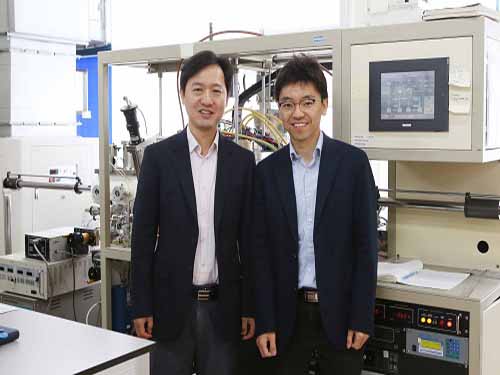 New Material for Generating Energy-Efficient Spin Currents
(Professor Byong-Guk Park (left) and Professor Kab-Jin Kim)
Magnetic random access memory (MRAM) is emerging as next-generation memory. It allows information to be kept even without an external power supply and its unique blend of high density and high speed operation is driving global semiconductor manufacturers to develop new versions continuously.
A KAIST team, led by Professor Byong-Guk Park in the Department of Materials Science and Engineering and Professor Kab-Jin Kim in the Department of Physics, recently has developed a new material which enables the efficient generation of a spin current, the core part of operating MRAM. This new material consisting of ferromagnet-transition metal bilayers can randomly control the direction of the generated spin current unlike the existing ones.
They also described a mechanism for spin-current generation at the interface between the bottom ferromagnetic layer and the non-magnetic spacer layer, which gives torques on the top magnetic layer that are consistent with the measured magnetization dependence.
When applying this to spin-orbit torque magnetic memory, it shows the increased efficiency of spin torque and generation of the spin current without an external magnetic field. High-speed operation, the distinct feature of spin-orbit torque-based MRAM that carries its non-volatility, can significantly reduce the standby power better than SRAM.
This new material will expect to speed up the commercialization of MRAM. The research team said that this magnetic memory will further be applied to mobile, wearable, and IoT devices.
This study, conducted in collaboration with Professor Kyung-Jin Lee from Korea University and Dr. Mark Stiles from the National Institute of Standards and Technology in the US, was featured in Nature Materials in March. The research was funded by the Creative Materials Discovery Program of the Ministry of Science and ICT.
(Figure: Ferromagnet-transition metal bilayers which can randomly control the direction of the generated spin current)
2018.05.11 View 11148
New Material for Generating Energy-Efficient Spin Currents
(Professor Byong-Guk Park (left) and Professor Kab-Jin Kim)
Magnetic random access memory (MRAM) is emerging as next-generation memory. It allows information to be kept even without an external power supply and its unique blend of high density and high speed operation is driving global semiconductor manufacturers to develop new versions continuously.
A KAIST team, led by Professor Byong-Guk Park in the Department of Materials Science and Engineering and Professor Kab-Jin Kim in the Department of Physics, recently has developed a new material which enables the efficient generation of a spin current, the core part of operating MRAM. This new material consisting of ferromagnet-transition metal bilayers can randomly control the direction of the generated spin current unlike the existing ones.
They also described a mechanism for spin-current generation at the interface between the bottom ferromagnetic layer and the non-magnetic spacer layer, which gives torques on the top magnetic layer that are consistent with the measured magnetization dependence.
When applying this to spin-orbit torque magnetic memory, it shows the increased efficiency of spin torque and generation of the spin current without an external magnetic field. High-speed operation, the distinct feature of spin-orbit torque-based MRAM that carries its non-volatility, can significantly reduce the standby power better than SRAM.
This new material will expect to speed up the commercialization of MRAM. The research team said that this magnetic memory will further be applied to mobile, wearable, and IoT devices.
This study, conducted in collaboration with Professor Kyung-Jin Lee from Korea University and Dr. Mark Stiles from the National Institute of Standards and Technology in the US, was featured in Nature Materials in March. The research was funded by the Creative Materials Discovery Program of the Ministry of Science and ICT.
(Figure: Ferromagnet-transition metal bilayers which can randomly control the direction of the generated spin current)
2018.05.11 View 11148 -
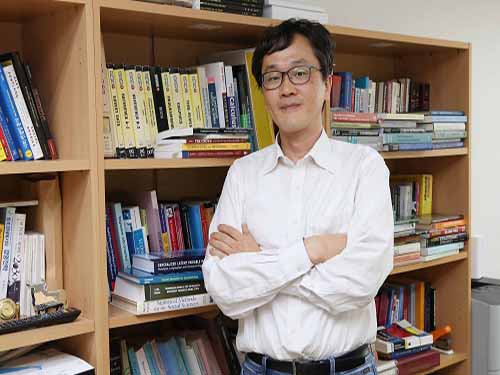 Escalation of Competition Leads to Conflict in Competitive Networks of F1 Drivers
(Professor Wonjae Lee at the Graduate School of Culture Technology)
A new study has revealed that people with similar social status in similar age groups are more likely to clash with each other. This rivalry could likely lead to taking more risks in fair weather conditions.
Competition, while is often seen as beneficial, can escalate into destructive conflict. This occurs, for instance, when athletes sabotage each other or when rival executives get caught up in a career-derailing fight. These escalations, which lead to conflict, are especially likely among similar-status competitors, who are fraught with discordant understandings of who is superior to whom.
A research team of KAIST, the US Treasury, INSEAD, and the European School of Management and Technology (ESMT) examined the link between status similarity and conflict as well as the conditions under which this link holds by using panel data on Formula 1 races from 1970 through 2014. For the study, the research team analyzed a total of 506 collision cases by 355 F1 drivers over 45 years.
The team found that similar-status F1 drivers are more prone to collide, especially when they are age-similar, performing well, and feeling safe. When these boundary conditions are met, structural equivalence likely triggers antagonism among interactants.
This research deepens the understanding of when violent conflict emerges and when prevention efforts are called for. Professor Lee from the Graduate School of Culture Technology at KAIST said, “People are not sure about their identity when facing competitors of a similar status. People tend to confirm their own stature by beating an opponent.”
The team investigated the factors that escalate competition into dangerous conflict. Recently, sociological theorizing claims that such escalations are particularly likely in pairs of structurally equivalent actors who have the same relations with the same third parties. Using the F1 data, the research team modeled the probability that two drivers would collide on a racetrack as a function of their structural equivalence in a dynamic network of competitive relationships.
Professor Lee added, “We fully understand that the drivers who ranked first and second are likely to have more conflict because they meet more frequently and know each other well. We also regulated all those conditions and confirmed that our hypothesis worked right throughout the data analysis.”
Professor Lee, who wrote his doctoral thesis on tennis tournaments for identifying the ideal organizational structure, said that sports tournaments would be best optimized for comprehending the nature of organizational structures. Tournaments, even those with rankings based on objective criteria, are in fact intensely social. However, most prior empirical work in this area has relied only on official information on competitors’ performance, thus failing to capture the important elements of past competitive encounters.
“It is not so easy to obtain data on rivalries and conflicts inside an organization. However, in sports, the performances of athletes are all recorded and the data can be utilized as a very objective methodology for understanding social relations and their structural affects.
Official positions in tournaments, although clearly informative, can also be reductionist –excluding the emotionally salient features of competitors’ histories and forcing competitors together on a scalar metric, even when the competitors themselves do not see each other as comparable.
The results from sample-split models are important for social networking research, which has paid scant attention to the contextual conditions in which structural equivalence is most consequential for social action – especially hostile social actions.
The study suggests that new work will benefit from examining how demographic overlap, network stability, and perceived costs of conflict “activate” a structurally equivalent relationship to the point that it is not only salient but also conducive to conflict.
Professor Lee said, “Sociology mainly investigates the positive results of social success and collaboration. This study shows that any violent activities, including homicide, also have something to do with organizational and social structural equivalence.”
This study was co-led by Professor Matthew Bothner from ESMT in Germany, Professor Henning Piezunk from INSEAD in France, and Dr. Richard Haynes from the US Treasury and was featured at the PNAS (Proceedings of the National Academy of Sciences of the USA) in March.
(Figure: Drivers' competitive network and collisions. Nodes are drivers. Nodes enricled in black are labeled by name. Edges denote joint competition in at least one race. Red edges connecting indicate that the two drivers collided at least once. Using Fruchtermna-Reingold, nodes are generally proximte to the extendt that their average structural equivalence (over all races, from 1970 to 2014) is high.)
2018.04.24 View 7740
Escalation of Competition Leads to Conflict in Competitive Networks of F1 Drivers
(Professor Wonjae Lee at the Graduate School of Culture Technology)
A new study has revealed that people with similar social status in similar age groups are more likely to clash with each other. This rivalry could likely lead to taking more risks in fair weather conditions.
Competition, while is often seen as beneficial, can escalate into destructive conflict. This occurs, for instance, when athletes sabotage each other or when rival executives get caught up in a career-derailing fight. These escalations, which lead to conflict, are especially likely among similar-status competitors, who are fraught with discordant understandings of who is superior to whom.
A research team of KAIST, the US Treasury, INSEAD, and the European School of Management and Technology (ESMT) examined the link between status similarity and conflict as well as the conditions under which this link holds by using panel data on Formula 1 races from 1970 through 2014. For the study, the research team analyzed a total of 506 collision cases by 355 F1 drivers over 45 years.
The team found that similar-status F1 drivers are more prone to collide, especially when they are age-similar, performing well, and feeling safe. When these boundary conditions are met, structural equivalence likely triggers antagonism among interactants.
This research deepens the understanding of when violent conflict emerges and when prevention efforts are called for. Professor Lee from the Graduate School of Culture Technology at KAIST said, “People are not sure about their identity when facing competitors of a similar status. People tend to confirm their own stature by beating an opponent.”
The team investigated the factors that escalate competition into dangerous conflict. Recently, sociological theorizing claims that such escalations are particularly likely in pairs of structurally equivalent actors who have the same relations with the same third parties. Using the F1 data, the research team modeled the probability that two drivers would collide on a racetrack as a function of their structural equivalence in a dynamic network of competitive relationships.
Professor Lee added, “We fully understand that the drivers who ranked first and second are likely to have more conflict because they meet more frequently and know each other well. We also regulated all those conditions and confirmed that our hypothesis worked right throughout the data analysis.”
Professor Lee, who wrote his doctoral thesis on tennis tournaments for identifying the ideal organizational structure, said that sports tournaments would be best optimized for comprehending the nature of organizational structures. Tournaments, even those with rankings based on objective criteria, are in fact intensely social. However, most prior empirical work in this area has relied only on official information on competitors’ performance, thus failing to capture the important elements of past competitive encounters.
“It is not so easy to obtain data on rivalries and conflicts inside an organization. However, in sports, the performances of athletes are all recorded and the data can be utilized as a very objective methodology for understanding social relations and their structural affects.
Official positions in tournaments, although clearly informative, can also be reductionist –excluding the emotionally salient features of competitors’ histories and forcing competitors together on a scalar metric, even when the competitors themselves do not see each other as comparable.
The results from sample-split models are important for social networking research, which has paid scant attention to the contextual conditions in which structural equivalence is most consequential for social action – especially hostile social actions.
The study suggests that new work will benefit from examining how demographic overlap, network stability, and perceived costs of conflict “activate” a structurally equivalent relationship to the point that it is not only salient but also conducive to conflict.
Professor Lee said, “Sociology mainly investigates the positive results of social success and collaboration. This study shows that any violent activities, including homicide, also have something to do with organizational and social structural equivalence.”
This study was co-led by Professor Matthew Bothner from ESMT in Germany, Professor Henning Piezunk from INSEAD in France, and Dr. Richard Haynes from the US Treasury and was featured at the PNAS (Proceedings of the National Academy of Sciences of the USA) in March.
(Figure: Drivers' competitive network and collisions. Nodes are drivers. Nodes enricled in black are labeled by name. Edges denote joint competition in at least one race. Red edges connecting indicate that the two drivers collided at least once. Using Fruchtermna-Reingold, nodes are generally proximte to the extendt that their average structural equivalence (over all races, from 1970 to 2014) is high.)
2018.04.24 View 7740 -
 Animal Cyborg: Behavioral Control by 'Toy' Craving Circuit
Children love to get toys from parents for their birthday present. This craving toward items also involves object hoarding disorders and shopping addiction. However, the biological meaning of why the brain pursues objects or items has remained unknown. Part of the answer may lie with a neural circuit in the hypothalamus associated with “object craving,” says neuroscientist Daesoo Kim from the Department of Biological Sciences at KAIST.
His research team found that some neurons in the hypothalamus are activated during playing with toys in mice. Thanks to optogenetics, they proved that these neurons in the hypothalamus actually governs obsessive behavior toward non-food objects in mice.
“When we stimulate a neuron in the hypothalamus of mice, they anxiously chased target objects. We found evidence that the neural circuits in the medial preoptic area (MPA) modulate “object craving,” the appetite for possessing objects” said Professor Kim.
Researchers also proved that the MPA circuit facilitate hunting behavior in response to crickets, a natural prey to mice, showing the role of this circuit for catching prey. Further, the MPA nerves send excitatory signals to the periaqueductal gray (PAG), located around the cerebral aqueduct, to create such behavior. The team named this circuit the ‘MPA-PAG’ circuit.
The team showed that they could control mammalian behavior for the first time with this scheme of MPA-Induced Drive Assisted Steering (MIDAS), in which a mouse chase the target objects in the front of head during stimulation of the MPA-PAG circuit. MIDAS allows mice to overcome obstacles to move in a desired path using optogenetics.
(Professor Daesoo Kim)
Professor Kim, who teamed up with Professor Phill Seung Lee in the Department of Mechanical Engineering, explained the significance of the research, “This study provides evidence to treat brain disorders such as compulsive hoarding and kleptomania. It also contributes to the development of technology to control the behavior of animals and humans using strong innate motivation, and thus could impact neuro-economics, defense, and disaster relief.”
He said the team would like to complete the neural circuit map governing behaviors of possession and hunting in the near future by exploring correlations with other neural behaviors controlling possessing and hunting activities.
This research was funded by the Samsung Science and Technology Foundation and published in Nature Neuroscience in March 2018.
(Figure 1: Schematics showing possessive behavior induced by the MPA neural circuit)
(Figure 2: Schematics of the MIDAS system that controls mammals behavior using the desire to possess. A MIDAS mouse is following the bait object controlled wirelessly.)
2018.04.23 View 10459
Animal Cyborg: Behavioral Control by 'Toy' Craving Circuit
Children love to get toys from parents for their birthday present. This craving toward items also involves object hoarding disorders and shopping addiction. However, the biological meaning of why the brain pursues objects or items has remained unknown. Part of the answer may lie with a neural circuit in the hypothalamus associated with “object craving,” says neuroscientist Daesoo Kim from the Department of Biological Sciences at KAIST.
His research team found that some neurons in the hypothalamus are activated during playing with toys in mice. Thanks to optogenetics, they proved that these neurons in the hypothalamus actually governs obsessive behavior toward non-food objects in mice.
“When we stimulate a neuron in the hypothalamus of mice, they anxiously chased target objects. We found evidence that the neural circuits in the medial preoptic area (MPA) modulate “object craving,” the appetite for possessing objects” said Professor Kim.
Researchers also proved that the MPA circuit facilitate hunting behavior in response to crickets, a natural prey to mice, showing the role of this circuit for catching prey. Further, the MPA nerves send excitatory signals to the periaqueductal gray (PAG), located around the cerebral aqueduct, to create such behavior. The team named this circuit the ‘MPA-PAG’ circuit.
The team showed that they could control mammalian behavior for the first time with this scheme of MPA-Induced Drive Assisted Steering (MIDAS), in which a mouse chase the target objects in the front of head during stimulation of the MPA-PAG circuit. MIDAS allows mice to overcome obstacles to move in a desired path using optogenetics.
(Professor Daesoo Kim)
Professor Kim, who teamed up with Professor Phill Seung Lee in the Department of Mechanical Engineering, explained the significance of the research, “This study provides evidence to treat brain disorders such as compulsive hoarding and kleptomania. It also contributes to the development of technology to control the behavior of animals and humans using strong innate motivation, and thus could impact neuro-economics, defense, and disaster relief.”
He said the team would like to complete the neural circuit map governing behaviors of possession and hunting in the near future by exploring correlations with other neural behaviors controlling possessing and hunting activities.
This research was funded by the Samsung Science and Technology Foundation and published in Nature Neuroscience in March 2018.
(Figure 1: Schematics showing possessive behavior induced by the MPA neural circuit)
(Figure 2: Schematics of the MIDAS system that controls mammals behavior using the desire to possess. A MIDAS mouse is following the bait object controlled wirelessly.)
2018.04.23 View 10459 -
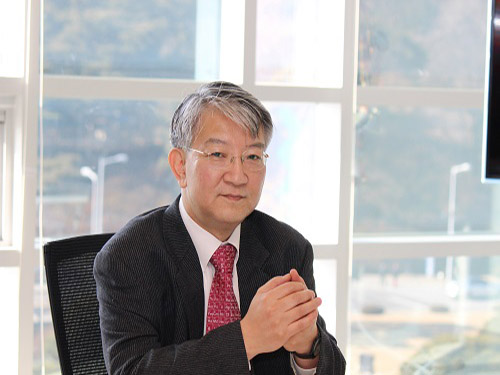 Deep Learning Predicts Drug-Drug and Drug-Food Interactions
A Korean research team from KAIST developed a computational framework, DeepDDI, that accurately predicts and generates 86 types of drug-drug and drug-food interactions as outputs of human-readable sentences, which allows in-depth understanding of the drug-drug and drug-food interactions.
Drug interactions, including drug-drug interactions (DDIs) and drug-food constituent interactions (DFIs), can trigger unexpected pharmacological effects, including adverse drug events (ADEs), with causal mechanisms often unknown. However, current prediction methods do not provide sufficient details beyond the chance of DDI occurrence, or require detailed drug information often unavailable for DDI prediction.
To tackle this problem, Dr. Jae Yong Ryu, Assistant Professor Hyun Uk Kim and Distinguished Professor Sang Yup Lee, all from the Department of Chemical and Biomolecular Engineering at Korea Advanced Institute of Science and Technology (KAIST), developed a computational framework, named DeepDDI, that accurately predicts 86 DDI types for a given drug pair. The research results were published online in Proceedings of the National Academy of Sciences of the United States of America (PNAS) on April 16, 2018, which is entitled “Deep learning improves prediction of drug-drug and drug-food interactions.”
DeepDDI takes structural information and names of two drugs in pair as inputs, and predicts relevant DDI types for the input drug pair. DeepDDI uses deep neural network to predict 86 DDI types with a mean accuracy of 92.4% using the DrugBank gold standard DDI dataset covering 192,284 DDIs contributed by 191,878 drug pairs. Very importantly, DDI types predicted by DeepDDI are generated in the form of human-readable sentences as outputs, which describe changes in pharmacological effects and/or the risk of ADEs as a result of the interaction between two drugs in pair. For example, DeepDDI output sentences describing potential interactions between oxycodone (opioid pain medication) and atazanavir (antiretroviral medication) were generated as follows: “The metabolism of Oxycodone can be decreased when combined with Atazanavir”; and “The risk or severity of adverse effects can be increased when Oxycodone is combined with Atazanavir”. By doing this, DeepDDI can provide more specific information on drug interactions beyond the occurrence chance of DDIs or ADEs typically reported to date.
DeepDDI was first used to predict DDI types of 2,329,561 drug pairs from all possible combinations of 2,159 approved drugs, from which DDI types of 487,632 drug pairs were newly predicted. Also, DeepDDI can be used to suggest which drug or food to avoid during medication in order to minimize the chance of adverse drug events or optimize the drug efficacy. To this end, DeepDDI was used to suggest potential causal mechanisms for the reported ADEs of 9,284 drug pairs, and also predict alternative drug candidates for 62,707 drug pairs having negative health effects to keep only the beneficial effects. Furthermore, DeepDDI was applied to 3,288,157 drug-food constituent pairs (2,159 approved drugs and 1,523 well-characterized food constituents) to predict DFIs. The effects of 256 food constituents on pharmacological effects of interacting drugs and bioactivities of 149 food constituents were also finally predicted. All these prediction results can be useful if an individual is taking medications for a specific (chronic) disease such as hypertension or diabetes mellitus type 2.
Distinguished Professor Sang Yup Lee said, “We have developed a platform technology DeepDDI that will allow precision medicine in the era of Fourth Industrial Revolution. DeepDDI can serve to provide important information on drug prescription and dietary suggestions while taking certain drugs to maximize health benefits and ultimately help maintain a healthy life in this aging society.”
Figure 1. Overall scheme of Deep DDDI and prediction of food constituents that reduce the in vivo concentration of approved drugs
2018.04.18 View 13011
Deep Learning Predicts Drug-Drug and Drug-Food Interactions
A Korean research team from KAIST developed a computational framework, DeepDDI, that accurately predicts and generates 86 types of drug-drug and drug-food interactions as outputs of human-readable sentences, which allows in-depth understanding of the drug-drug and drug-food interactions.
Drug interactions, including drug-drug interactions (DDIs) and drug-food constituent interactions (DFIs), can trigger unexpected pharmacological effects, including adverse drug events (ADEs), with causal mechanisms often unknown. However, current prediction methods do not provide sufficient details beyond the chance of DDI occurrence, or require detailed drug information often unavailable for DDI prediction.
To tackle this problem, Dr. Jae Yong Ryu, Assistant Professor Hyun Uk Kim and Distinguished Professor Sang Yup Lee, all from the Department of Chemical and Biomolecular Engineering at Korea Advanced Institute of Science and Technology (KAIST), developed a computational framework, named DeepDDI, that accurately predicts 86 DDI types for a given drug pair. The research results were published online in Proceedings of the National Academy of Sciences of the United States of America (PNAS) on April 16, 2018, which is entitled “Deep learning improves prediction of drug-drug and drug-food interactions.”
DeepDDI takes structural information and names of two drugs in pair as inputs, and predicts relevant DDI types for the input drug pair. DeepDDI uses deep neural network to predict 86 DDI types with a mean accuracy of 92.4% using the DrugBank gold standard DDI dataset covering 192,284 DDIs contributed by 191,878 drug pairs. Very importantly, DDI types predicted by DeepDDI are generated in the form of human-readable sentences as outputs, which describe changes in pharmacological effects and/or the risk of ADEs as a result of the interaction between two drugs in pair. For example, DeepDDI output sentences describing potential interactions between oxycodone (opioid pain medication) and atazanavir (antiretroviral medication) were generated as follows: “The metabolism of Oxycodone can be decreased when combined with Atazanavir”; and “The risk or severity of adverse effects can be increased when Oxycodone is combined with Atazanavir”. By doing this, DeepDDI can provide more specific information on drug interactions beyond the occurrence chance of DDIs or ADEs typically reported to date.
DeepDDI was first used to predict DDI types of 2,329,561 drug pairs from all possible combinations of 2,159 approved drugs, from which DDI types of 487,632 drug pairs were newly predicted. Also, DeepDDI can be used to suggest which drug or food to avoid during medication in order to minimize the chance of adverse drug events or optimize the drug efficacy. To this end, DeepDDI was used to suggest potential causal mechanisms for the reported ADEs of 9,284 drug pairs, and also predict alternative drug candidates for 62,707 drug pairs having negative health effects to keep only the beneficial effects. Furthermore, DeepDDI was applied to 3,288,157 drug-food constituent pairs (2,159 approved drugs and 1,523 well-characterized food constituents) to predict DFIs. The effects of 256 food constituents on pharmacological effects of interacting drugs and bioactivities of 149 food constituents were also finally predicted. All these prediction results can be useful if an individual is taking medications for a specific (chronic) disease such as hypertension or diabetes mellitus type 2.
Distinguished Professor Sang Yup Lee said, “We have developed a platform technology DeepDDI that will allow precision medicine in the era of Fourth Industrial Revolution. DeepDDI can serve to provide important information on drug prescription and dietary suggestions while taking certain drugs to maximize health benefits and ultimately help maintain a healthy life in this aging society.”
Figure 1. Overall scheme of Deep DDDI and prediction of food constituents that reduce the in vivo concentration of approved drugs
2018.04.18 View 13011 -
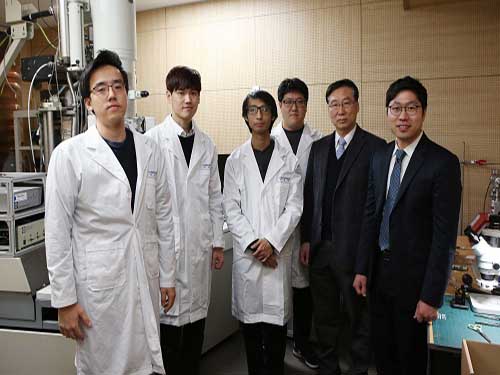 KAIST Develops Sodium Ion Batteries using Copper Sulfide
A KAIST research team recently developed sodium ion batteries using copper sulfide anode. This finding will contribute to advancing the commercialization of sodium ion batteries (SIBs) and reducing the production cost of any electronic products with batteries.
Professor Jong Min Yuk and Emeritus Professor Jeong Yong Lee from Department of Materials Science and Engineering succeeded in developing a new anode material suitable for use in a SIB. Compared to the existing anode materials, the copper sulfide anode was measured to exhibit 1.5 times better cyclability with projected 40% reduction in cost.
Batteries used in various applications including mobile phones are lithium ion batteries, mostly referred as Li-ion batteries or LIBs. Though they are popularly used until now, large-scale energy storage systems require much inexpensive and abundant materials. Hence, a SIB has attracted enormous attention for their advantage over a lithium counterpart.
However, one main obstacle to commercialization of SIB is the lack of suitable anodes that exhibit high capacity and the cycling stability of the battery. Hence, the research team recognized this need for a good anode material that could offer high electrical conductivity and theoretical capacity. The material was found to be copper sulfide, preferably in nanoplates, which “prefers to make an alloy with sodium and is thus promising for high capacity and long-term cyclability.”
Further analysis presented in the study reveals that copper sulfide undergoes crystallographic tuning to make a room for sodium insertion. Results indicate that the sodium ion-insertion capacity of copper sulfide is as much as 1.5 times that of lithium ions for graphite. Furthermore, a battery with this new anode material retains 90% of its original capacity for 250 charge-discharge cycles.
With the natural abundance of sodium in seawater, this development may contribute to reduction in battery costs, which can be translated into up to 30% cut in the price of various consumer electronics.
Professor Lee expressed his hope for “the production of next-generation, high-performance sodium ion batteries”.
Professor Yuk said, “These days, people are showing a great deal of interest in products related to renewable energy due to recent micro-dust issues ongoing in Korea. This study may help Korea get a head-start on renewable energy products”.
This research, led by PhD candidate Jae Yeol Park and Dr. Sung Joo Kim, was published online in Nature Communications on March 2.
Figure 1. The sodiation process of copper sulfide
2018.04.17 View 7131
KAIST Develops Sodium Ion Batteries using Copper Sulfide
A KAIST research team recently developed sodium ion batteries using copper sulfide anode. This finding will contribute to advancing the commercialization of sodium ion batteries (SIBs) and reducing the production cost of any electronic products with batteries.
Professor Jong Min Yuk and Emeritus Professor Jeong Yong Lee from Department of Materials Science and Engineering succeeded in developing a new anode material suitable for use in a SIB. Compared to the existing anode materials, the copper sulfide anode was measured to exhibit 1.5 times better cyclability with projected 40% reduction in cost.
Batteries used in various applications including mobile phones are lithium ion batteries, mostly referred as Li-ion batteries or LIBs. Though they are popularly used until now, large-scale energy storage systems require much inexpensive and abundant materials. Hence, a SIB has attracted enormous attention for their advantage over a lithium counterpart.
However, one main obstacle to commercialization of SIB is the lack of suitable anodes that exhibit high capacity and the cycling stability of the battery. Hence, the research team recognized this need for a good anode material that could offer high electrical conductivity and theoretical capacity. The material was found to be copper sulfide, preferably in nanoplates, which “prefers to make an alloy with sodium and is thus promising for high capacity and long-term cyclability.”
Further analysis presented in the study reveals that copper sulfide undergoes crystallographic tuning to make a room for sodium insertion. Results indicate that the sodium ion-insertion capacity of copper sulfide is as much as 1.5 times that of lithium ions for graphite. Furthermore, a battery with this new anode material retains 90% of its original capacity for 250 charge-discharge cycles.
With the natural abundance of sodium in seawater, this development may contribute to reduction in battery costs, which can be translated into up to 30% cut in the price of various consumer electronics.
Professor Lee expressed his hope for “the production of next-generation, high-performance sodium ion batteries”.
Professor Yuk said, “These days, people are showing a great deal of interest in products related to renewable energy due to recent micro-dust issues ongoing in Korea. This study may help Korea get a head-start on renewable energy products”.
This research, led by PhD candidate Jae Yeol Park and Dr. Sung Joo Kim, was published online in Nature Communications on March 2.
Figure 1. The sodiation process of copper sulfide
2018.04.17 View 7131 -
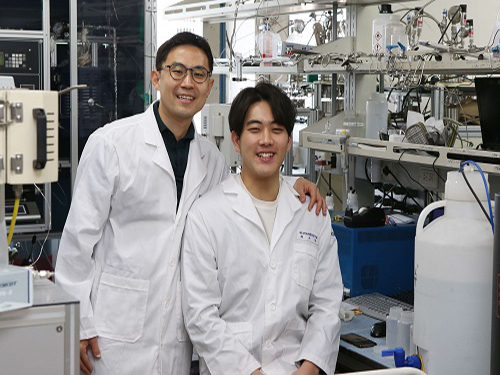 Producing 50x More Stable Adsorbent
A KAIST research team developed a technology to increase the stability of amine-containing adsorbents by fifty times, moving one step further toward commercializing stable adsorbents that last longer.
Professor Minkee Choi from the Department of Chemical and Biomolecular Engineering and his team succeeded in developing amine-containing adsorbents that show high oxidative stability.
The capture of the greenhouse gas carbon dioxide is an active ongoing research field, and some of the latest advancements point to amine-containing adsorbents as an efficient and environment-friendly way to capture carbon dioxide. However, existing amine-containing adsorbents are known to be unstable under oxidation, which chemically breaks down the adsorbent, thereby making it difficult to rely on amine-containing adsorbents for repeated and continued use.
The researchers have discovered that the miniscule amount of iron and copper present in the amine accelerate the oxidative breakdown of the amine-containing adsorbent. Upon this discovery, they proposed the use of a chelator substance, which essentially suppresses the activation of the impurities.
The team demonstrates that the proposed method renders the adsorbent up to 50 times slower in its deactivation rate due to oxidation, compared to conventional polyethyleneimine (PEI) / silica adsorbents. Figure 1 illustrates the superior performance of this oxidation-stable amine-containing adsorbent (shown in black squares), whose carbon dioxide-capturing capacity deteriorates by only a small amount (~8%). Meanwhile, the carbon dioxide-capturing capacity of the PEI/silica adsorbent (shown in red diamonds) degrades dramatically after being exposed to oxidative aging for 30 days.
This stability under oxidation is expected to have brought amine-containing adsorbents one step closer to commercialization. As such, first author Woosung Choi describes the significance of this study as “having brought solid carbon dioxide adsorbents to commercializable standards”. In fact, Professor Choi explains that commercialization steps for his team’s carbon dioxide adsorbents are already underway. He further set forth his aim to “develop the world’s best carbon dioxide capture adsorbent”.
This research, led by the PhD candidate Woosung Choi, was published online in Nature Communications on February 20.
Figure 1. Carbon dioxide working capacity against oxidative aging time. Performance of the proposed method (black) degrades much more slowly (~50x) than that of existing methods. The novel adsorbent is thus shown to be more robust to oxidation.
2018.04.16 View 6436
Producing 50x More Stable Adsorbent
A KAIST research team developed a technology to increase the stability of amine-containing adsorbents by fifty times, moving one step further toward commercializing stable adsorbents that last longer.
Professor Minkee Choi from the Department of Chemical and Biomolecular Engineering and his team succeeded in developing amine-containing adsorbents that show high oxidative stability.
The capture of the greenhouse gas carbon dioxide is an active ongoing research field, and some of the latest advancements point to amine-containing adsorbents as an efficient and environment-friendly way to capture carbon dioxide. However, existing amine-containing adsorbents are known to be unstable under oxidation, which chemically breaks down the adsorbent, thereby making it difficult to rely on amine-containing adsorbents for repeated and continued use.
The researchers have discovered that the miniscule amount of iron and copper present in the amine accelerate the oxidative breakdown of the amine-containing adsorbent. Upon this discovery, they proposed the use of a chelator substance, which essentially suppresses the activation of the impurities.
The team demonstrates that the proposed method renders the adsorbent up to 50 times slower in its deactivation rate due to oxidation, compared to conventional polyethyleneimine (PEI) / silica adsorbents. Figure 1 illustrates the superior performance of this oxidation-stable amine-containing adsorbent (shown in black squares), whose carbon dioxide-capturing capacity deteriorates by only a small amount (~8%). Meanwhile, the carbon dioxide-capturing capacity of the PEI/silica adsorbent (shown in red diamonds) degrades dramatically after being exposed to oxidative aging for 30 days.
This stability under oxidation is expected to have brought amine-containing adsorbents one step closer to commercialization. As such, first author Woosung Choi describes the significance of this study as “having brought solid carbon dioxide adsorbents to commercializable standards”. In fact, Professor Choi explains that commercialization steps for his team’s carbon dioxide adsorbents are already underway. He further set forth his aim to “develop the world’s best carbon dioxide capture adsorbent”.
This research, led by the PhD candidate Woosung Choi, was published online in Nature Communications on February 20.
Figure 1. Carbon dioxide working capacity against oxidative aging time. Performance of the proposed method (black) degrades much more slowly (~50x) than that of existing methods. The novel adsorbent is thus shown to be more robust to oxidation.
2018.04.16 View 6436 -
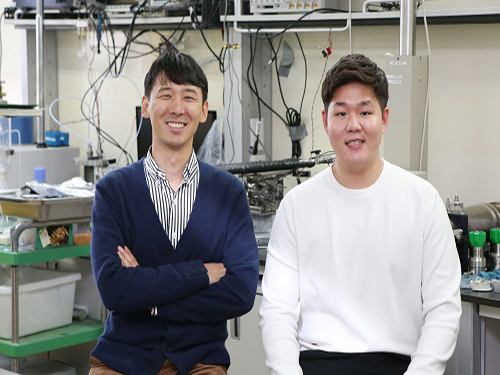 Formation of Burning Ice in Oceanic Clay Rich Sediment Disclosed
(from left: Professor Tae-Hyuk Kwon and PhD candidate Taehyung Park) A KAIST research team has identified the formation of natural gas hydrates, so-called flammable ice, formed in oceans.
Professor Tae-Hyuk Kwon from the Department of Civil & Environmental Engineering and his team found that clay minerals in oceanic clay-rich sedimentary deposits promote formation of gas hydrates and proposed the principle of gas hydrate formation in the clayey sedimentary layers.
Gas hydrates are ice-like crystalline structures composed of hydrogen-bonded water molecules encapsulating gas molecules. They are also known as burning ice. Their deposits are so huge that they gain attention for alternative energy.
Conventionally, it was believed that formation of gas hydrates is limited in clay sedimentary deposits; however, unexpected abundance of natural gas hydrates in oceanic clay-rich sedimentary deposits raised the issue of how they formed.
The surfaces of natural clay minerals are negatively charged and, thus, unavoidably generate physicochemical interactions between clay and water. Such clay-water interactions have a critical role in the occurrence of natural gas hydrates in clay-rich sedimentary formations.
However, there has been experimental difficulty in analyzing hydrate formation because of the cations contained in clay particles, which balance the clay surface charges. Therefore, clay particles inevitably release the cations when mixed with water, which complicates the interpretation of experimental results.
To overcome this limitation, the team polarized water molecules with an electric field and monitored the induction times of water molecules forming gas hydrates.
They found that the 10 kV/m of electric field promoted gas hydrate nucleation under certain conditions rather than slowing it down, due to the partial breakage of the hydrogen bonded water clusters and the lowered thermal energy of water molecules.
Professor Kwon said, “Through this research, we gained better insight into the origin of gas hydrates occurrence in clay-rich sedimentary deposits. In the near future, we will soon be able to commercially produce methane gas from natural gas hydrate deposits.”
This research, led by PhD candidate Taehyung Park, was published online in Environmental Science and Technology on February 3. (doi: 10.1021/acs.est.7b05477)
Figure 1. Formation of gas hydrates with water molecules
Figure 2. Enhancement and inhibition of gas hydrates
2018.04.09 View 6946
Formation of Burning Ice in Oceanic Clay Rich Sediment Disclosed
(from left: Professor Tae-Hyuk Kwon and PhD candidate Taehyung Park) A KAIST research team has identified the formation of natural gas hydrates, so-called flammable ice, formed in oceans.
Professor Tae-Hyuk Kwon from the Department of Civil & Environmental Engineering and his team found that clay minerals in oceanic clay-rich sedimentary deposits promote formation of gas hydrates and proposed the principle of gas hydrate formation in the clayey sedimentary layers.
Gas hydrates are ice-like crystalline structures composed of hydrogen-bonded water molecules encapsulating gas molecules. They are also known as burning ice. Their deposits are so huge that they gain attention for alternative energy.
Conventionally, it was believed that formation of gas hydrates is limited in clay sedimentary deposits; however, unexpected abundance of natural gas hydrates in oceanic clay-rich sedimentary deposits raised the issue of how they formed.
The surfaces of natural clay minerals are negatively charged and, thus, unavoidably generate physicochemical interactions between clay and water. Such clay-water interactions have a critical role in the occurrence of natural gas hydrates in clay-rich sedimentary formations.
However, there has been experimental difficulty in analyzing hydrate formation because of the cations contained in clay particles, which balance the clay surface charges. Therefore, clay particles inevitably release the cations when mixed with water, which complicates the interpretation of experimental results.
To overcome this limitation, the team polarized water molecules with an electric field and monitored the induction times of water molecules forming gas hydrates.
They found that the 10 kV/m of electric field promoted gas hydrate nucleation under certain conditions rather than slowing it down, due to the partial breakage of the hydrogen bonded water clusters and the lowered thermal energy of water molecules.
Professor Kwon said, “Through this research, we gained better insight into the origin of gas hydrates occurrence in clay-rich sedimentary deposits. In the near future, we will soon be able to commercially produce methane gas from natural gas hydrate deposits.”
This research, led by PhD candidate Taehyung Park, was published online in Environmental Science and Technology on February 3. (doi: 10.1021/acs.est.7b05477)
Figure 1. Formation of gas hydrates with water molecules
Figure 2. Enhancement and inhibition of gas hydrates
2018.04.09 View 6946 -
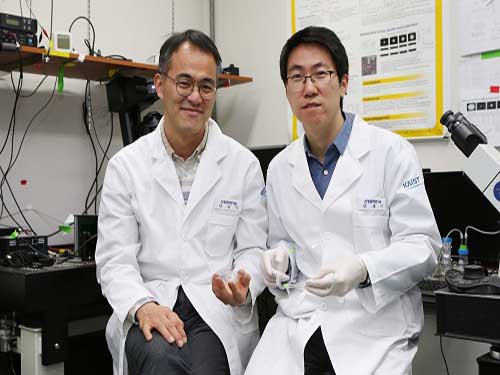 Printed Thermo-Plasmonic Heat Patterns for Neurological Disorder Treatment
(Professor Nam and Dr. Kang, right)
A KAIST team presented a highly customizable neural stimulation method. The research team developed a technology that can print the heat pattern on a micron scale to enable the control of biological activities remotely.
The researchers integrated a precision inkjet printing technology with bio-functional thermo-plasmonic nanoparticles to achieve a ‘selective nano-photothermal neural stimulation method.’
The research team of Professor Yoonkey Nam at the Department of Bio and Brain Engineering expects this will serve as an enabling technology for personalized precision neuromodulation therapy for patients with neurological disorders.
The nano-photothermal neural stimulation method uses the thermo-plasmonic effect of metal nanoparticles to modulate the activities of neuronal networks. With the thermo-plasmonic effect, metal nanoparticles can absorb specific wavelength of illuminated light to efficiently generate localized heat. The research team discovered the inhibitory behavior of spontaneous activities of neurons upon photothermal stimulation four years ago. Since then, they have developed this technology to control hyperactive behaviors of neurons and neural circuits, which is often found in neurological disorders such as epilepsy.
In order to overcome the limitation on the spatial selectivity and resolution of the previously developed nano-photothermal method, the team adopted an inkjet printing technology to micro pattern the plasmonic nanoparticles (a few tens of microns), and successfully demonstrated that the nano-photothermal stimulation can be selectively applied according to the printed patterns.
The researchers applied a polyelectrolyte layer-by-layer coating method to printing substrates in a way to improve the pattern fidelity and achieve the uniform assembly of nanoparticles. The electrostatic attraction between the printed nanoparticles and the coated printing substrate also helped the stability of the attached nanoparticles. Because the polyelectrolyte coating is biocompatible, biological experiments including cell culture are possible with the technology developed in this work.
Using printed gold nanorod particles in a few tens of microns resolution over a several centimeters area, the researchers showed that highly complex heat patterns can be precisely formed upon light illumination according to the printing image.
Lastly, the team confirmed that the printed heat patterns can selectively and instantaneously inhibit the activities of cultured hippocampal neurons upon near-infrared light illumination. Because the printing process is applicable to thin and flexible substrates, the technology can be easily applied to implantable neurological disorder treatment devices and wearable devices. By selectively applying the heat patterns to only the desired cellular areas, customized and personalized photothermal neuromodulation therapy can be applied to patients.
“The fact that any desired heat patterns can be simply ‘printed’ anywhere broadens the applicability of this technology in many engineering fields. In bioengineering, it can be applied to neural interfaces using light and heat to modulate physiological functions. As another engineering application, for example, printed heat patterns can be used as a new concept of anti-counterfeit applications,” said the principal investigator, Yoonkey Nam at KAIST. This work, led mainly by Dr. Hongki Kang, was published in ACS Nano on February 5th 2018.
2018.04.06 View 7475
Printed Thermo-Plasmonic Heat Patterns for Neurological Disorder Treatment
(Professor Nam and Dr. Kang, right)
A KAIST team presented a highly customizable neural stimulation method. The research team developed a technology that can print the heat pattern on a micron scale to enable the control of biological activities remotely.
The researchers integrated a precision inkjet printing technology with bio-functional thermo-plasmonic nanoparticles to achieve a ‘selective nano-photothermal neural stimulation method.’
The research team of Professor Yoonkey Nam at the Department of Bio and Brain Engineering expects this will serve as an enabling technology for personalized precision neuromodulation therapy for patients with neurological disorders.
The nano-photothermal neural stimulation method uses the thermo-plasmonic effect of metal nanoparticles to modulate the activities of neuronal networks. With the thermo-plasmonic effect, metal nanoparticles can absorb specific wavelength of illuminated light to efficiently generate localized heat. The research team discovered the inhibitory behavior of spontaneous activities of neurons upon photothermal stimulation four years ago. Since then, they have developed this technology to control hyperactive behaviors of neurons and neural circuits, which is often found in neurological disorders such as epilepsy.
In order to overcome the limitation on the spatial selectivity and resolution of the previously developed nano-photothermal method, the team adopted an inkjet printing technology to micro pattern the plasmonic nanoparticles (a few tens of microns), and successfully demonstrated that the nano-photothermal stimulation can be selectively applied according to the printed patterns.
The researchers applied a polyelectrolyte layer-by-layer coating method to printing substrates in a way to improve the pattern fidelity and achieve the uniform assembly of nanoparticles. The electrostatic attraction between the printed nanoparticles and the coated printing substrate also helped the stability of the attached nanoparticles. Because the polyelectrolyte coating is biocompatible, biological experiments including cell culture are possible with the technology developed in this work.
Using printed gold nanorod particles in a few tens of microns resolution over a several centimeters area, the researchers showed that highly complex heat patterns can be precisely formed upon light illumination according to the printing image.
Lastly, the team confirmed that the printed heat patterns can selectively and instantaneously inhibit the activities of cultured hippocampal neurons upon near-infrared light illumination. Because the printing process is applicable to thin and flexible substrates, the technology can be easily applied to implantable neurological disorder treatment devices and wearable devices. By selectively applying the heat patterns to only the desired cellular areas, customized and personalized photothermal neuromodulation therapy can be applied to patients.
“The fact that any desired heat patterns can be simply ‘printed’ anywhere broadens the applicability of this technology in many engineering fields. In bioengineering, it can be applied to neural interfaces using light and heat to modulate physiological functions. As another engineering application, for example, printed heat patterns can be used as a new concept of anti-counterfeit applications,” said the principal investigator, Yoonkey Nam at KAIST. This work, led mainly by Dr. Hongki Kang, was published in ACS Nano on February 5th 2018.
2018.04.06 View 7475 -
 A New Theory Improves Button Designs
Pressing a button appears effortless. People easily dismisses how challenging it is. Researchers at KAIST and Aalto University in Finland, created detailed simulations of button-pressing with the goal of producing human-like presses.
The researchers argue that the key capability of the brain is a probabilistic model. The brain learns a model that allows it to predict a suitable motor command for a button. If a press fails, it can pick a very good alternative and try it out. "Without this ability, we would have to learn to use every button like it was new," tells Professor Byungjoo Lee from the Graduate School of Culture Technology at KAIST.
After successfully activating the button, the brain can tune the motor command to be more precise, use less energy and to avoid stress or pain. "These factors together, with practice, produce the fast, minimum-effort, elegant touch people are able to perform."
The brain uses probabilistic models also to extract information optimally from the sensations that arise when the finger moves and its tip touches the button. It "enriches" the ephemeral sensations optimally based on prior experience to estimate the time the button was impacted. For example, tactile sensation from the tip of the finger a better predictor for button activation than proprioception (angle position) and visual feedback.
Best performance is achieved when all sensations are considered together. To adapt, the brain must fuse their information using prior experiences. Professor Lee explains, "We believe that the brain picks up these skills over repeated button pressings that start already as a child. What appears easy for us now has been acquired over years."
The research was triggered by admiration of our remarkable capability to adapt button-pressing. Professor Antti Oulasvirta at Aalto University said, "We push a button on a remote controller differently than a piano key. The press of a skilled user is surprisingly elegant when looked at terms of timing, reliability, and energy use. We successfully press buttons without ever knowing the inner workings of a button. It is essentially a black box to our motor system. On the other hand, we also fail to activate buttons, and some buttons are known to be worse than others."
Previous research has shown that touch buttons are worse than push-buttons, but there has not been adequate theoretical explanation.
"In the past, there has been very little attention to buttons, although we use them all the time" says Dr. Sunjun Kim from Aalto University. The new theory and simulations can be used to design better buttons.
"One exciting implication of the theory is that activating the button at the moment when the sensation is strongest will help users better rhythm their keypresses."
To test this hypothesis, the researchers created a new method for changing the way buttons are activated. The technique is called Impact Activation. Instead of activating the button at first contact, it activates it when the button cap or finger hits the floor with maximum impact.
The technique was 94% better in rapid tapping than the regular activation method for a push-button (Cherry MX switch) and 37% than a regular touchscreen button using a capacitive touch sensor. The technique can be easily deployed in touchscreens. However, regular physical keyboards do not offer the required sensing capability, although special products exist (e.g., the Wooting keyboard) on which it can be implemented.
The simulations shed new light on what happens during a button press. One problem the brain must overcome is that muscles do not activate as perfectly as we will, but every press is slightly different. Moreover, a button press is very fast, occurring within 100 milliseconds, and is too fast for correcting movement. The key to understanding button-pressing is therefore to understand how the brain adapts based on the limited sensations that are the residue of the brief press event.
The researchers also used the simulation to explain differences among physical and touchscreen-based button types. Both physical and touch buttons provide clear tactile signals from the impact of the tip with the button floor. However, with the physical button this signal is more pronounced and longer.
"Where the two button types also differ is the starting height of the finger, and this makes a difference," explains Professor Lee. "When we pull up the finger from the touchscreen, it will end up at different height every time. Its down-press cannot be as accurately controlled in time as with a push-button where the finger can rest on top of the key cap."
Three scientific articles, "Neuromechanics of a Button Press", "Impact activation improves rapid button pressing", and "Moving target selection: A cue integration model", will be presented at the CHI Conference on Human Factors in Computing Systems in Montréal, Canada, in April 2018.
2018.03.22 View 8128
A New Theory Improves Button Designs
Pressing a button appears effortless. People easily dismisses how challenging it is. Researchers at KAIST and Aalto University in Finland, created detailed simulations of button-pressing with the goal of producing human-like presses.
The researchers argue that the key capability of the brain is a probabilistic model. The brain learns a model that allows it to predict a suitable motor command for a button. If a press fails, it can pick a very good alternative and try it out. "Without this ability, we would have to learn to use every button like it was new," tells Professor Byungjoo Lee from the Graduate School of Culture Technology at KAIST.
After successfully activating the button, the brain can tune the motor command to be more precise, use less energy and to avoid stress or pain. "These factors together, with practice, produce the fast, minimum-effort, elegant touch people are able to perform."
The brain uses probabilistic models also to extract information optimally from the sensations that arise when the finger moves and its tip touches the button. It "enriches" the ephemeral sensations optimally based on prior experience to estimate the time the button was impacted. For example, tactile sensation from the tip of the finger a better predictor for button activation than proprioception (angle position) and visual feedback.
Best performance is achieved when all sensations are considered together. To adapt, the brain must fuse their information using prior experiences. Professor Lee explains, "We believe that the brain picks up these skills over repeated button pressings that start already as a child. What appears easy for us now has been acquired over years."
The research was triggered by admiration of our remarkable capability to adapt button-pressing. Professor Antti Oulasvirta at Aalto University said, "We push a button on a remote controller differently than a piano key. The press of a skilled user is surprisingly elegant when looked at terms of timing, reliability, and energy use. We successfully press buttons without ever knowing the inner workings of a button. It is essentially a black box to our motor system. On the other hand, we also fail to activate buttons, and some buttons are known to be worse than others."
Previous research has shown that touch buttons are worse than push-buttons, but there has not been adequate theoretical explanation.
"In the past, there has been very little attention to buttons, although we use them all the time" says Dr. Sunjun Kim from Aalto University. The new theory and simulations can be used to design better buttons.
"One exciting implication of the theory is that activating the button at the moment when the sensation is strongest will help users better rhythm their keypresses."
To test this hypothesis, the researchers created a new method for changing the way buttons are activated. The technique is called Impact Activation. Instead of activating the button at first contact, it activates it when the button cap or finger hits the floor with maximum impact.
The technique was 94% better in rapid tapping than the regular activation method for a push-button (Cherry MX switch) and 37% than a regular touchscreen button using a capacitive touch sensor. The technique can be easily deployed in touchscreens. However, regular physical keyboards do not offer the required sensing capability, although special products exist (e.g., the Wooting keyboard) on which it can be implemented.
The simulations shed new light on what happens during a button press. One problem the brain must overcome is that muscles do not activate as perfectly as we will, but every press is slightly different. Moreover, a button press is very fast, occurring within 100 milliseconds, and is too fast for correcting movement. The key to understanding button-pressing is therefore to understand how the brain adapts based on the limited sensations that are the residue of the brief press event.
The researchers also used the simulation to explain differences among physical and touchscreen-based button types. Both physical and touch buttons provide clear tactile signals from the impact of the tip with the button floor. However, with the physical button this signal is more pronounced and longer.
"Where the two button types also differ is the starting height of the finger, and this makes a difference," explains Professor Lee. "When we pull up the finger from the touchscreen, it will end up at different height every time. Its down-press cannot be as accurately controlled in time as with a push-button where the finger can rest on top of the key cap."
Three scientific articles, "Neuromechanics of a Button Press", "Impact activation improves rapid button pressing", and "Moving target selection: A cue integration model", will be presented at the CHI Conference on Human Factors in Computing Systems in Montréal, Canada, in April 2018.
2018.03.22 View 8128 -
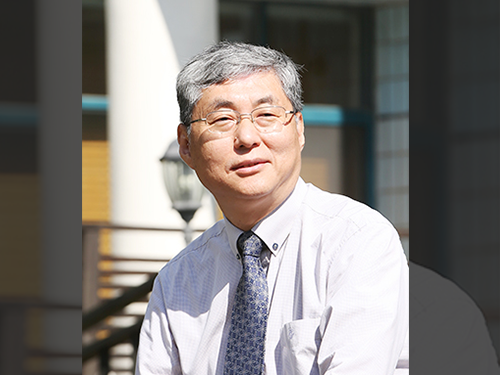 Recognizing Seven Different Face Emotions on a Mobile Platform
(Professor Hoi-Jun Yoo)
A KAIST research team succeeded in achieving face emotion recognition on a mobile platform by developing an AI semiconductor IC that processes two neural networks on a single chip.
Professor Hoi-Jun Yoo and his team (Primary researcher: Jinmook Lee Ph. D. student) from the School of Electrical Engineering developed a unified deep neural network processing unit (UNPU).
Deep learning is a technology for machine learning based on artificial neural networks, which allows a computer to learn by itself, just like a human.
The developed chip adjusts the weight precision (from 1 bit to 16 bit) of a neural network inside of the semiconductor in order to optimize energy efficiency and accuracy. With a single chip, it can process a convolutional neural network (CNN) and recurrent neural network (RNN) simultaneously. CNN is used for categorizing and recognizing images while RNN is for action recognition and speech recognition, such as time-series information.
Moreover, it enables an adjustment in energy efficiency and accuracy dynamically while recognizing objects. To realize mobile AI technology, it needs to process high-speed operations with low energy, otherwise the battery can run out quickly due to processing massive amounts of information at once. According to the team, this chip has better operation performance compared to world-class level mobile AI chips such as Google TPU. The energy efficiency of the new chip is 4 times higher than the TPU.
In order to demonstrate its high performance, the team installed UNPU in a smartphone to facilitate automatic face emotion recognition on the smartphone. This system displays a user’s emotions in real time. The research results for this system were presented at the 2018 International Solid-State Circuits Conference (ISSCC) in San Francisco on February 13.
Professor Yoo said, “We have developed a semiconductor that accelerates with low power requirements in order to realize AI on mobile platforms. We are hoping that this technology will be applied in various areas, such as object recognition, emotion recognition, action recognition, and automatic translation. Within one year, we will commercialize this technology.”
2018.03.09 View 7589
Recognizing Seven Different Face Emotions on a Mobile Platform
(Professor Hoi-Jun Yoo)
A KAIST research team succeeded in achieving face emotion recognition on a mobile platform by developing an AI semiconductor IC that processes two neural networks on a single chip.
Professor Hoi-Jun Yoo and his team (Primary researcher: Jinmook Lee Ph. D. student) from the School of Electrical Engineering developed a unified deep neural network processing unit (UNPU).
Deep learning is a technology for machine learning based on artificial neural networks, which allows a computer to learn by itself, just like a human.
The developed chip adjusts the weight precision (from 1 bit to 16 bit) of a neural network inside of the semiconductor in order to optimize energy efficiency and accuracy. With a single chip, it can process a convolutional neural network (CNN) and recurrent neural network (RNN) simultaneously. CNN is used for categorizing and recognizing images while RNN is for action recognition and speech recognition, such as time-series information.
Moreover, it enables an adjustment in energy efficiency and accuracy dynamically while recognizing objects. To realize mobile AI technology, it needs to process high-speed operations with low energy, otherwise the battery can run out quickly due to processing massive amounts of information at once. According to the team, this chip has better operation performance compared to world-class level mobile AI chips such as Google TPU. The energy efficiency of the new chip is 4 times higher than the TPU.
In order to demonstrate its high performance, the team installed UNPU in a smartphone to facilitate automatic face emotion recognition on the smartphone. This system displays a user’s emotions in real time. The research results for this system were presented at the 2018 International Solid-State Circuits Conference (ISSCC) in San Francisco on February 13.
Professor Yoo said, “We have developed a semiconductor that accelerates with low power requirements in order to realize AI on mobile platforms. We are hoping that this technology will be applied in various areas, such as object recognition, emotion recognition, action recognition, and automatic translation. Within one year, we will commercialize this technology.”
2018.03.09 View 7589 -
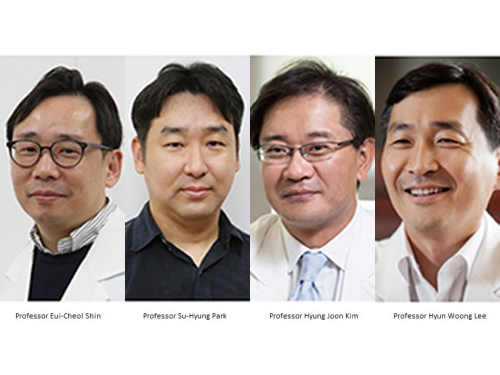 Activation of Bystander Immune Cells during Acute Hepatitis A.
A KAIST research team has identified a process of tissue damage caused by bystander immune cells in acute viral infections. This research will pave the way for research to understand the principles of tissue damage in viral infections and immune diseases, and can point toward a possible therapeutic target for the treatment.
Upon viral infection, viral replication itself destroys human cells, but in some cases, viral replication is not the direct cause of the tissue damage. In particular, the destruction of infected cells is the primary cause of tissue damage during non-cytopathic viral infections such as hepatitis A virus, hepatitis B virus and hepatitis C virus. However, the underlying pathological mechanisms involved in the tissue damage during viral infections have not been fully elucidated.
Specificity is one of the most important characteristics of the immune system. In general, infection from a certain virus specifically activates immune cells targeting the virus, while other immune cells specific to different viruses remain inactive.
An immune cell not specific to an infected virus is called a bystander immune cell. A phenomenon that activates irrelevant immune cells not originally targeting the infecting virus, called the activation of bystander immune cells, is already known to the world; however, its clinical significance has not been investigated thoroughly.
Professor Eui-Cheol Shin and Professor Su-Hyung Park from the Graduate School of Medical Science and Engineering analyzed patients with acute hepatitis A, in collaboration with Chung-Ang University Hospital.
The team found not only immune cells specifically targeting the hepatitis A virus were activated, but also bystander immune cells were activated and involved in the damaging of liver tissues during acute hepatitis A.
According to the research, when a person is infected with hepatitis A virus, hepatitis A virus-infected cells produce IL-15, which induces the activation of bystander immune cells. Activated bystander immune cells exert innate-like cytotoxicity, triggered by activating receptors NKG2D and NKp30 and this can lead to liver injury.
Through describing the cause of excessive tissue damage during acute viral hepatitis, the research outcome is expected to provide critical contributions for the development of potential therapeutic intervention that can minimize tissue damage caused by viral hepatitis and immune disorders.
Professor Shin said, “This is a novel research case that discovered the clinical significance of bystander immune cell activation, which was previously unknown. We will continue to work on establishing treatments which could prevent tissue damage in viral and immune diseases in the future.”
This research was published in Immunity on January 2.
Figure 1. Graphical abstract
2018.03.06 View 7323
Activation of Bystander Immune Cells during Acute Hepatitis A.
A KAIST research team has identified a process of tissue damage caused by bystander immune cells in acute viral infections. This research will pave the way for research to understand the principles of tissue damage in viral infections and immune diseases, and can point toward a possible therapeutic target for the treatment.
Upon viral infection, viral replication itself destroys human cells, but in some cases, viral replication is not the direct cause of the tissue damage. In particular, the destruction of infected cells is the primary cause of tissue damage during non-cytopathic viral infections such as hepatitis A virus, hepatitis B virus and hepatitis C virus. However, the underlying pathological mechanisms involved in the tissue damage during viral infections have not been fully elucidated.
Specificity is one of the most important characteristics of the immune system. In general, infection from a certain virus specifically activates immune cells targeting the virus, while other immune cells specific to different viruses remain inactive.
An immune cell not specific to an infected virus is called a bystander immune cell. A phenomenon that activates irrelevant immune cells not originally targeting the infecting virus, called the activation of bystander immune cells, is already known to the world; however, its clinical significance has not been investigated thoroughly.
Professor Eui-Cheol Shin and Professor Su-Hyung Park from the Graduate School of Medical Science and Engineering analyzed patients with acute hepatitis A, in collaboration with Chung-Ang University Hospital.
The team found not only immune cells specifically targeting the hepatitis A virus were activated, but also bystander immune cells were activated and involved in the damaging of liver tissues during acute hepatitis A.
According to the research, when a person is infected with hepatitis A virus, hepatitis A virus-infected cells produce IL-15, which induces the activation of bystander immune cells. Activated bystander immune cells exert innate-like cytotoxicity, triggered by activating receptors NKG2D and NKp30 and this can lead to liver injury.
Through describing the cause of excessive tissue damage during acute viral hepatitis, the research outcome is expected to provide critical contributions for the development of potential therapeutic intervention that can minimize tissue damage caused by viral hepatitis and immune disorders.
Professor Shin said, “This is a novel research case that discovered the clinical significance of bystander immune cell activation, which was previously unknown. We will continue to work on establishing treatments which could prevent tissue damage in viral and immune diseases in the future.”
This research was published in Immunity on January 2.
Figure 1. Graphical abstract
2018.03.06 View 7323